Setting the Fee Recipient for Lido CSM Validators
When running validators via Lido Community Staking Module (CSM), it is mandatory to set the fee recipient to the Lido Execution Layer Rewards Vault:
- Mainnet:
0x388C818CA8B9251b393131C08a736A67ccB19297 - Hoodi testnet:
0x9b108015fe433F173696Af3Aa0CF7CDb3E104258
For Hoodi Testnet users:
Use 0x9b108015fe433F173696Af3Aa0CF7CDb3E104258 instead of 0x388C818CA8B9251b393131C08a736A67ccB19297 in the guides below.
Failure to do so may result in MEV stealing penalties, including:
- A penalty equal to the stolen execution layer rewards plus a fixed fine
- Your bond being locked until the full penalty amount is returned
This guide shows you how to correctly set the fee recipient on various platforms. It does not cover how to set up or run a validator node from scratch.
You can verify the fee recipient address on the Lido Deployed Contracts page.
Dappnode
Dappnode sets the fee recipient through the Staking Brain in the Web3Signer package, either during key import or by editing existing validator keys.
Set fee recipient when importing new validator keys
Step 1: In the side panel, go to “Stakers”, then select the Web3Signer package and click “Upload Keystores” to open the Staking Brain.
Step 2: Enable “Use same tag for every file”, and in the “Staking Protocol” dropdown, select “Lido”. This automatically sets the fee recipient to:
0x388C818CA8B9251b393131C08a736A67ccB19297
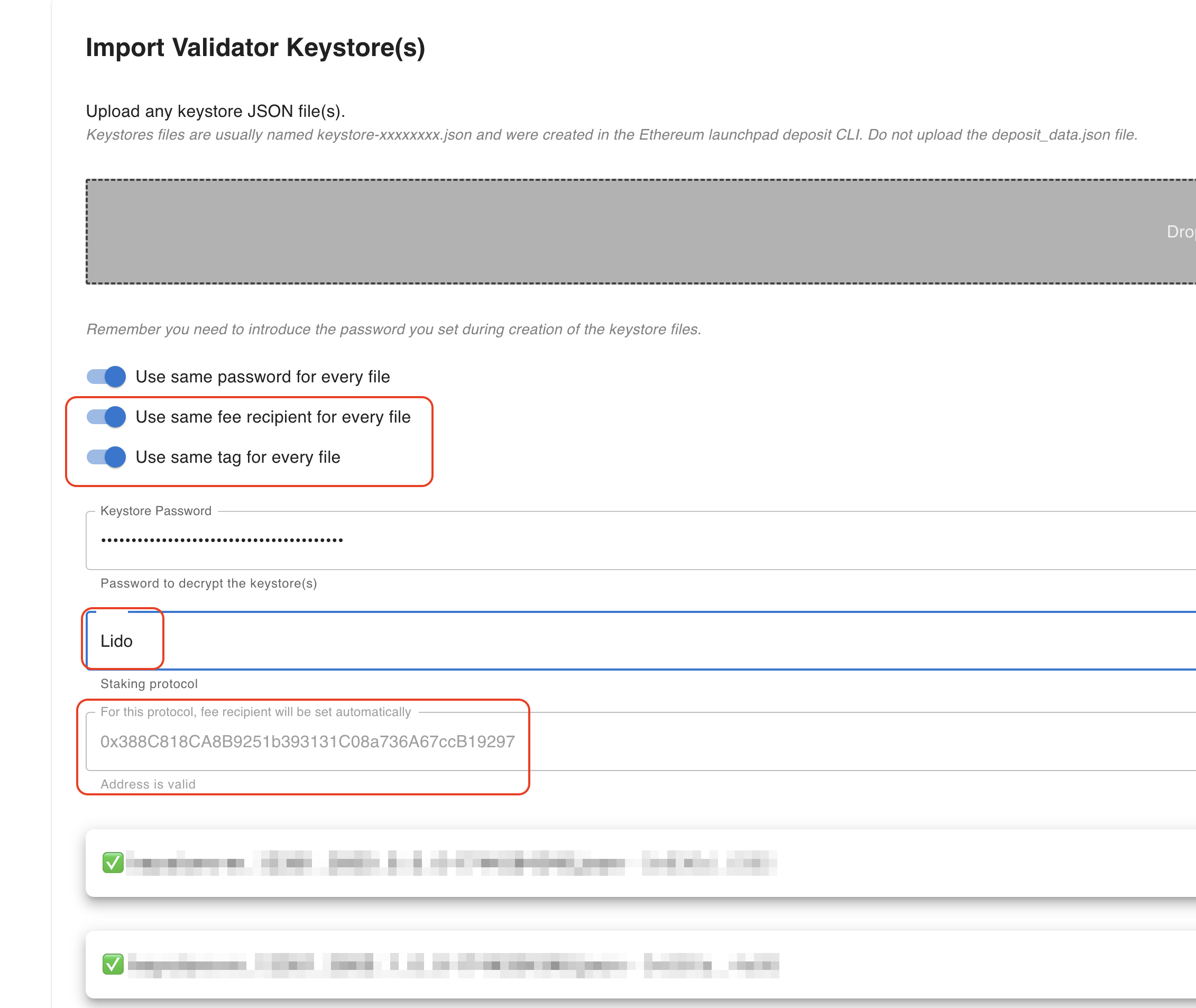
Step 3: Click “Submit Keystores” to complete the import.
Change fee recipient on existing validator keys
Step 1: In the side panel, go to “Stakers”, then select the Web3Signer package and click “Upload Keystores”.
Step 2: Review the Fee Recipient field for each validator key. If it's incorrect or missing, click the edit icon.
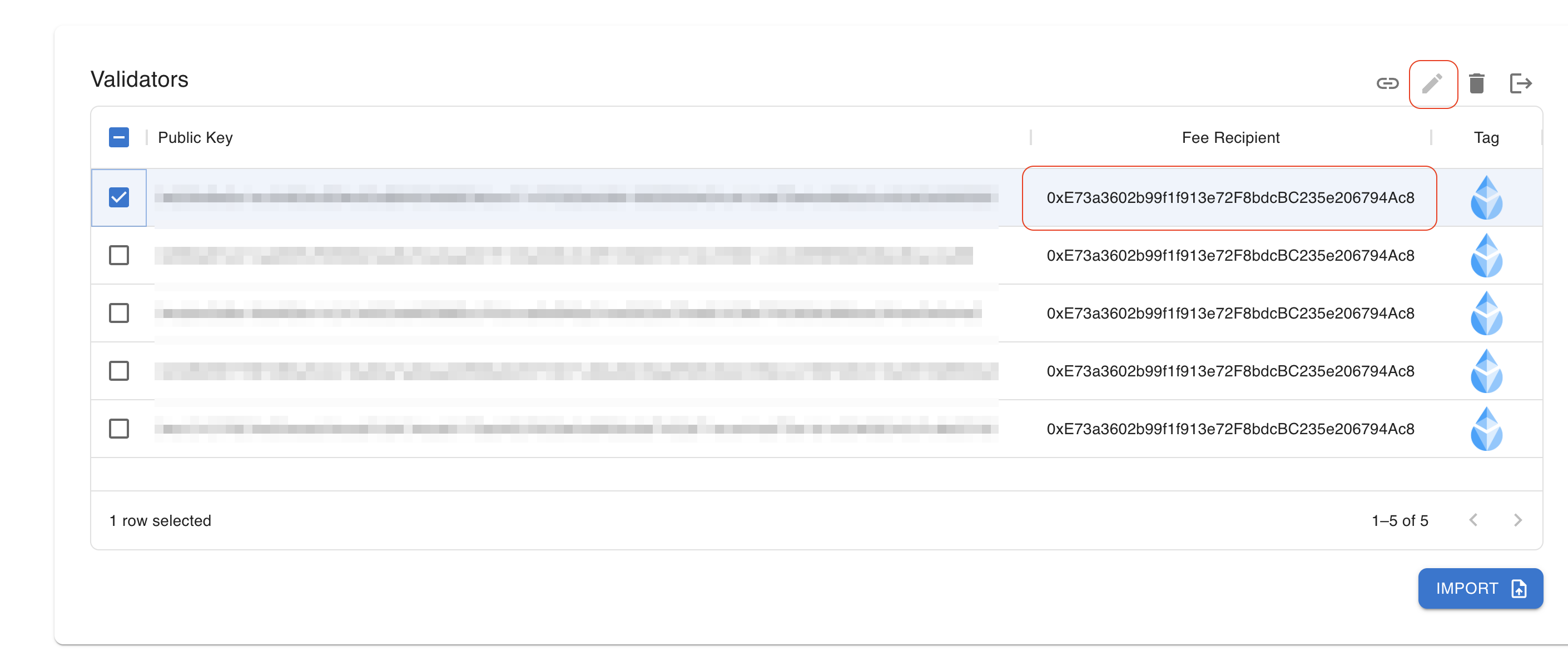
Step 3: Set the fee recipient to: 0x388C818CA8B9251b393131C08a736A67ccB19297
Step 4: Click “Submit Keystores” to apply the changes.
Known issue with Nimbus on Dappnode
Several users have reported that when running Nimbus with Dappnode, the fee recipient set in the Staking Brain (Web3Signer) is not applied. Instead, the fee recipient set on the consensus layer node is used, which can result in MEV stealing, when it is not set to the Lido Execution Layer Rewards Vault.
This issue has been acknowledged by the Dappnode team but has not been confirmed as resolved.
We do not recommend running Nimbus with Dappnode for Lido CSM validators until the issue is conclusively fixed. Consider switching to another consensus client if you’re currently running Nimbus.
Eth-Docker
If you're using Eth-Docker (typically located in ~/eth-docker), follow these steps to check or set the correct fee recipient.
Step 1: Edit the .env file
Open the .env file in your Eth-Docker directory:
cd ~/eth-docker
nano .env
Make sure the following line is present and correctly set:
FEE_RECIPIENT=0x388C818CA8B9251b393131C08a736A67ccB19297
If the line already exists with a different value, update it to match the correct Lido address.
Step 2: Save and exit
Save the file and exit your editor (in nano: press CTRL+O, ENTER, then CTRL+X).
Step 3: Apply the configuration
Run the update command to regenerate and restart the services with the new configuration:
./ethd update
./ethd up
If the address was already correct, you can keep Eth-Docker running without restarting.
Sedge
If you're using Sedge to manage your validator stack, follow these steps to check or set the correct fee recipient.
Step 1: Navigate to the sedge-data folder
cd <your-sedge-folder>/sedge-data
Step 2: Edit the .env file
nano .env
Ensure this line exists and is set correctly:
FEE_RECIPIENT=0x388C818CA8B9251b393131C08a736A67ccB19297
If the line already exists with a different value, update it to match the correct Lido address.
Step 3: Save and exit
Save the file and exit your editor (in nano: press CTRL+O, ENTER, then CTRL+X).
Step 4: Restart Sedge
If you made any changes, restart Sedge:
./sedge down
./sedge run
If the address was already correct, you can keep Sedge running without restarting.
Stereum
If you're using Stereum to manage your Ethereum node and validators, follow these steps to verify or update the fee recipient address.
Step 1: Open your Node Page
Access the node management interface in Stereum.
Step 2: Go to the Validator Client Settings
In the interface, locate your validator client and click the settings icon.
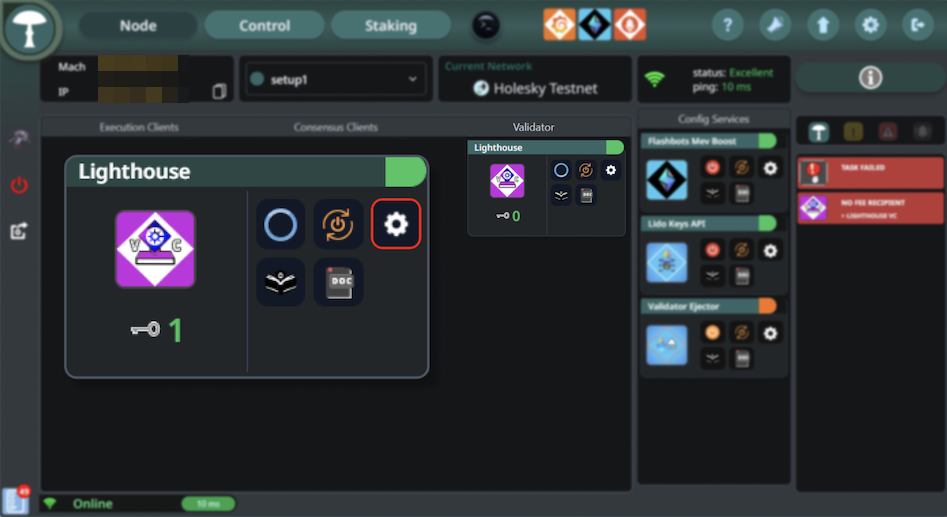
Step 3: Locate "Default Fee Recipient"
Find the field labeled "Default Fee Recipient".
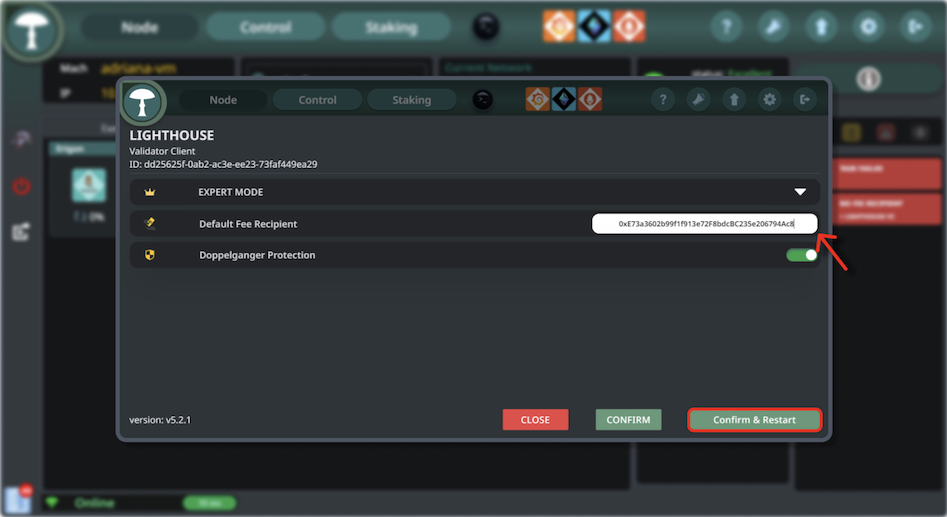
Step 4: Verify or update the address
Make sure it is set to: 0x388C818CA8B9251b393131C08a736A67ccB19297
If the address is missing or incorrect, enter the correct one.
Step 5: Confirm and restart
Click "Confirm & Restart" to save your changes and restart the validator client.
Stereum sets the Lido fee recipient automatically, but you should still manually verify it is correct before restarting your node.
SSV Network
If you're running CSM validators using SSV, make sure your Fee Recipient Address is set correctly in the SSV dApp.
Step 1: Open the SSV dApp
Navigate to the SSV dApp and log in with the wallet that registered your validator cluster.
Step 2: Open the fee recipient settings
Click on "Fee Address" in the top right corner of the screen.

Step 3: Set the correct fee recipient address
In the "Fee Recipient Address" field, enter:
0x388C818CA8B9251b393131C08a736A67ccB19297
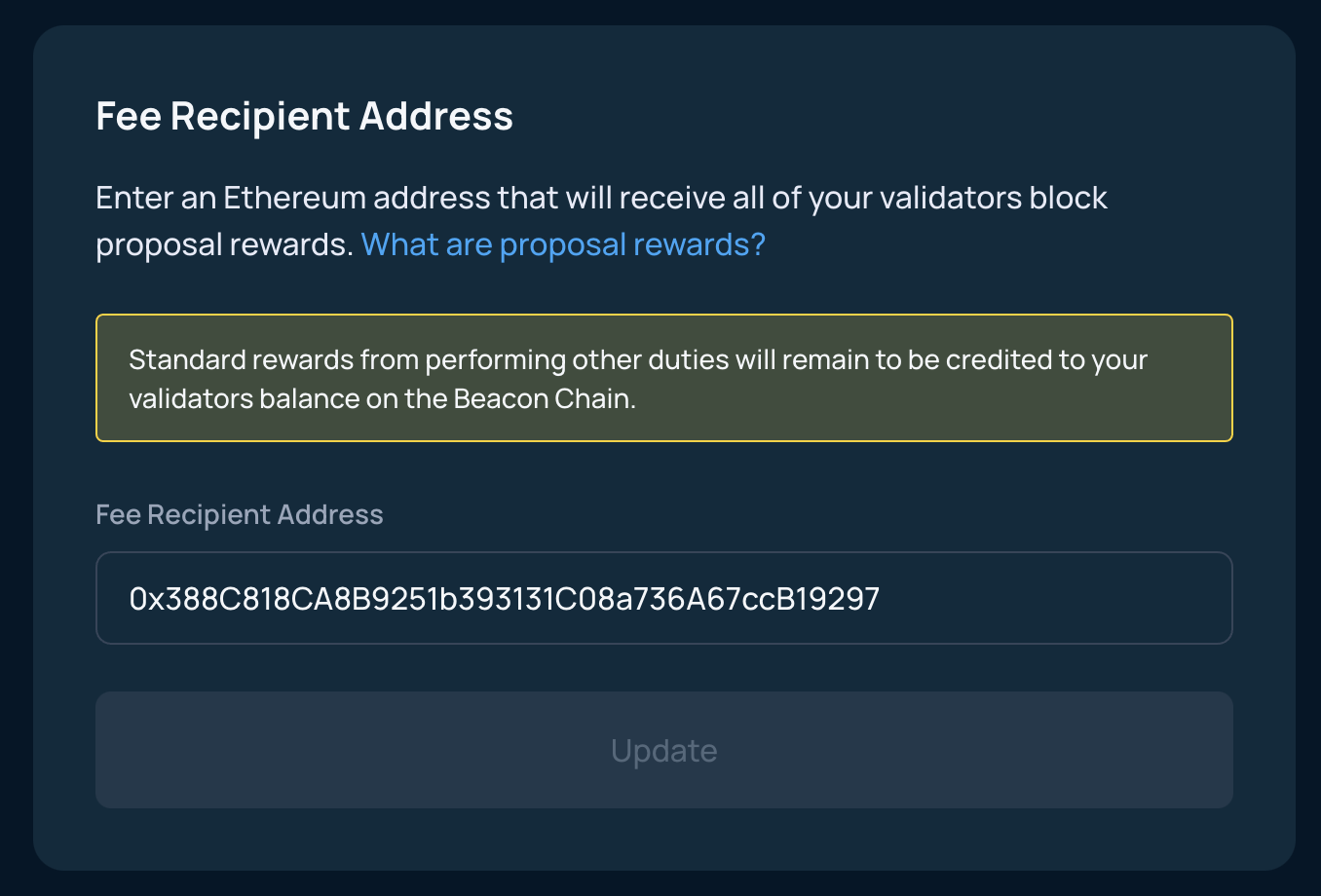
If the field is empty or shows a different address, update it and click "Update" to initiate the transaction.
The fee recipient address is set per wallet, not per cluster!
If you're running validators with SSV for other protocols in parallel, you must use a separate wallet to set a different fee recipient.
Obol
In Obol DVT setups, the fee recipient is configured by the cluster leader during cluster creation.
Fee recipient setup options
- Using the Obol DV Launchpad:
If you select "Lido CSM" under withdrawal configuration, the fee recipient is automatically set to:0x388C818CA8B9251b393131C08a736A67ccB19297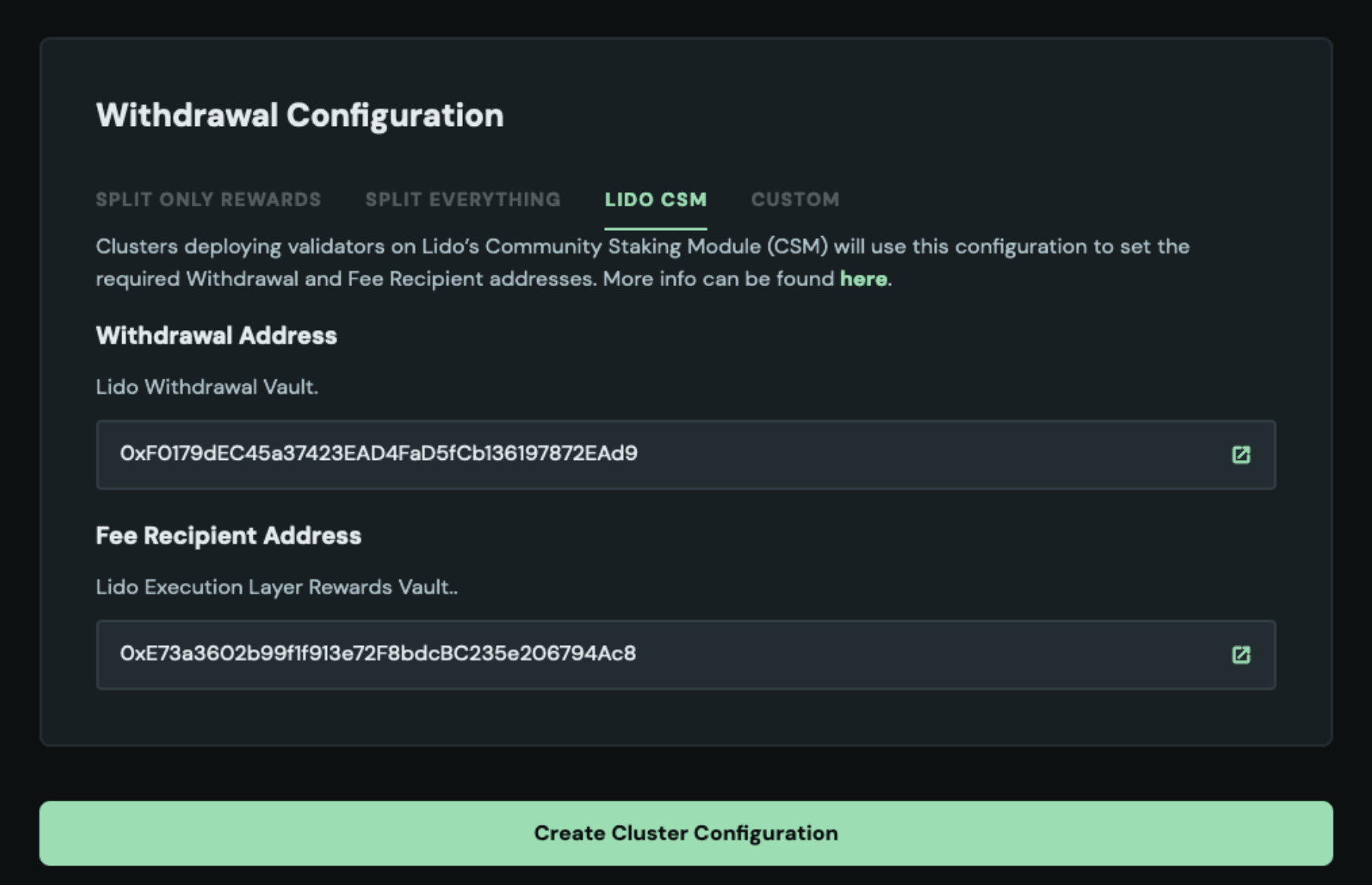
- Using the CLI:
You must manually set the correct fee recipient address when creating the cluster definition file.
Before finalizing the cluster creation, double-check that the fee recipient is correctly set. Once the cluster is created, you cannot change the fee recipient.
If the wrong address was set, the only solution is to exit your validators and create a new cluster with the correct fee recipient address.
Systemd
Step 1: Open your validator client’s systemd service file.
Typically located in /etc/systemd/system/
Step 2: Update the service file with the appropriate flag and address:
Lighthouse
ExecStart=/usr/local/bin/lighthouse vc \
--suggested-fee-recipient=0x388C818CA8B9251b393131C08a736A67ccB19297 \
[other flags...]
Prysm
ExecStart=/usr/local/bin/validator \
--suggested-fee-recipient=0x388C818CA8B9251b393131C08a736A67ccB19297 \
[other flags...]
Teku
ExecStart=/usr/local/bin/teku/bin/teku validator-client \
--validators-proposer-default-fee-recipient=0x388C818CA8B9251b393131C08a736A67ccB19297 \
[other flags...]
Nimbus
ExecStart=/usr/local/bin/nimbus_validator_client \
--suggested-fee-recipient=0x388C818CA8B9251b393131C08a736A67ccB19297 \
[other flags...]
Lodestar
ExecStart=/usr/bin/lodestar validator \
--suggestedFeeRecipient=0x388C818CA8B9251b393131C08a736A67ccB19297 \
[other flags...]
Step 3: Reload and restart the service
sudo systemctl daemon-reload
sudo systemctl restart <your-validator-service>
Verify Your Fee Recipient
It’s important to verify your fee recipient configuration before your validator proposes a block, as incorrect settings may result in protocol penalties.
Check your local configuration
Make sure the fee recipient address is set to:
0x388C818CA8B9251b393131C08a736A67ccB19297
Check this in your setup as follows:
- Dappnode: open the
Staking Brainand review theFee Recipientfield for each validator. - Stereum: open the UI and check the fee recipient field in the validator client settings.
- Eth-Docker / Sedge: inspect your
.envfile and confirm theFEE_RECIPIENTvariable is set correctly. - SSV: log in to app.ssv.network, click on Fee Address, and verify the address.
- Obol: check your cluster definition file or Launchpad configuration before deploying.
- systemd: inspect your validator service file (
/etc/systemd/system/<validator-client>.service) and confirm the correct--fee-recipientor equivalent flag is set.
Check client logs
Most validator clients log the configured fee recipient address during startup.
Check your startup logs and confirm that the fee recipient is set to the Lido Execution Layer Rewards Vault.
Seek Lido's help
If you're running a validator client or using a custom setup not covered in this guide, and need help setting the correct fee recipient address, the Lido Community Validator Specialists (Chimera) are here to help.
Join the Lido Discord and tag:
@community-validator-support
We’ll assist you in configuring your setup correctly to avoid penalties.